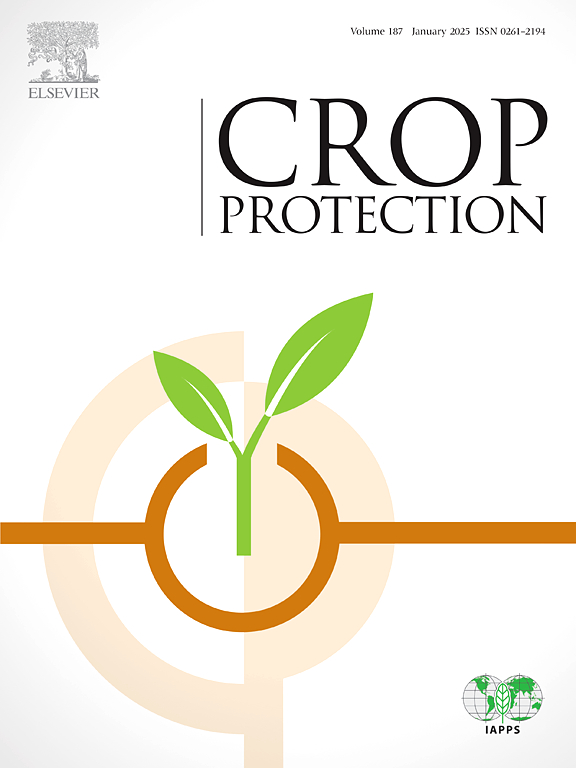Evaluation of Fusarium ear rot and fumonisins in twenty Zambian maize genotypes
IF 2.5
2区 农林科学
Q1 AGRONOMY
引用次数: 0
Abstract
Fusarium ear rot (FER) of maize, caused by Fusarium verticillioides, significantly impacts grain quantity and quality due to reduced yield and grain discolorations. The fungus produces fumonisins (FUM), a mycotoxin associated with noxious effects on humans and animals. In 2019/20 and 2020/21 seasons, 20 maize genotypes were evaluated for tolerance to FER/FUM contamination in field experiments conducted at Mt. Makulu and Msekera Research Stations located in Chilanga and Chipata districts respectively. Maize (Zea mays L.) plants were artificially inoculated with characterised Zambian isolates of F. verticillioides, and FER disease symptoms visually assessed. The accumulation of FUM in grain was quantified by liquid chromatography tandem mass spectrometry. Commercial hybrids, ZM04 (8.4 %; 207.6 μg kg−1), ZM15 (14.7 %; 281.4 μg kg−1) and ZM07 (17.4 %, 374.2 μg kg−1) consistently accumulated significantly lower FER severity and FUM when compared to the resistant check ZM01 (19.2 %; 384.1 μg kg−1) over the two years. ZM04 and ZM07 reaction to FER and FUM was stable in both environments. This study has demonstrated that the Zambian germplasm can serve as a valuable source of resistance to FER. Therefore, information on the tolerant genotypes should be shared with small-scale farmers to enable them to make informed decisions regarding the best genotypes to grow.
20个赞比亚玉米基因型穗腐镰刀菌和伏马菌素的鉴定
玉米穗腐病(Fusarium verticillioides, FER)是由黄萎病引起的玉米穗腐病,会导致产量下降和籽粒变色,严重影响籽粒数量和品质。这种真菌产生伏马菌素(FUM),这是一种对人类和动物有害的真菌毒素。在2019/20和2020/21季节,分别在Chilanga和Chipata地区的Mt Makulu和Msekera研究站进行了田间试验,评估了20种玉米基因型对FER/FUM污染的耐受性。将玉米(Zea mays L.)植株人工接种有特征的赞比亚黄萎病杆菌分离株,并对其疾病症状进行目视评估。采用液相色谱-串联质谱法测定了谷物中FUM的积累量。商用混合动力车ZM04 (8.4%;207.6 μg kg−1),ZM15 (14.7%;281.4 μg kg−1)和ZM07 (17.4%, 374.2 μg kg−1)累积的FER严重程度和FUM均显著低于抗性检查ZM01 (19.2%;384.1 μg kg−1)。ZM04和ZM07对FER和FUM的反应在两种环境下均稳定。这项研究表明,赞比亚种质资源可以作为一个有价值的抗性来源。因此,应与小农分享有关耐受性基因型的信息,使他们能够就种植的最佳基因型做出明智的决定。
本文章由计算机程序翻译,如有差异,请以英文原文为准。
求助全文
约1分钟内获得全文
求助全文
来源期刊

Crop Protection
农林科学-农艺学
CiteScore
6.10
自引率
3.60%
发文量
200
审稿时长
29 days
期刊介绍:
The Editors of Crop Protection especially welcome papers describing an interdisciplinary approach showing how different control strategies can be integrated into practical pest management programs, covering high and low input agricultural systems worldwide. Crop Protection particularly emphasizes the practical aspects of control in the field and for protected crops, and includes work which may lead in the near future to more effective control. The journal does not duplicate the many existing excellent biological science journals, which deal mainly with the more fundamental aspects of plant pathology, applied zoology and weed science. Crop Protection covers all practical aspects of pest, disease and weed control, including the following topics:
-Abiotic damage-
Agronomic control methods-
Assessment of pest and disease damage-
Molecular methods for the detection and assessment of pests and diseases-
Biological control-
Biorational pesticides-
Control of animal pests of world crops-
Control of diseases of crop plants caused by microorganisms-
Control of weeds and integrated management-
Economic considerations-
Effects of plant growth regulators-
Environmental benefits of reduced pesticide use-
Environmental effects of pesticides-
Epidemiology of pests and diseases in relation to control-
GM Crops, and genetic engineering applications-
Importance and control of postharvest crop losses-
Integrated control-
Interrelationships and compatibility among different control strategies-
Invasive species as they relate to implications for crop protection-
Pesticide application methods-
Pest management-
Phytobiomes for pest and disease control-
Resistance management-
Sampling and monitoring schemes for diseases, nematodes, pests and weeds.
 求助内容:
求助内容: 应助结果提醒方式:
应助结果提醒方式:


